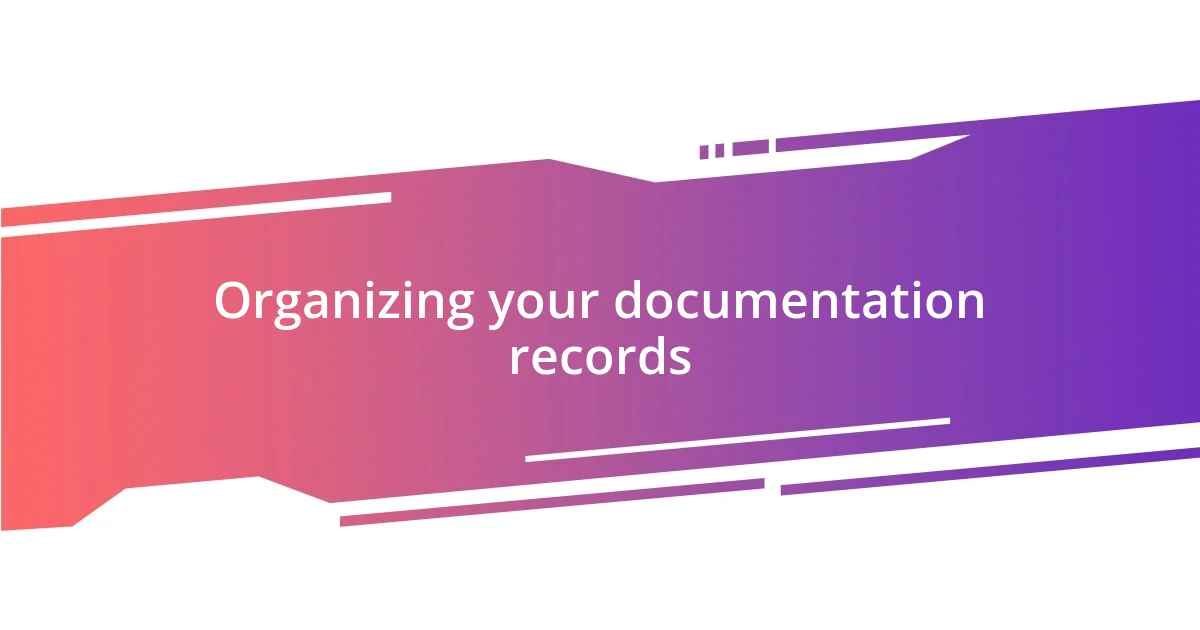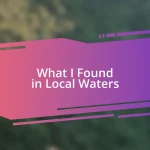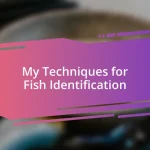Key takeaways:
- Documentation of fish species enhances understanding of biodiversity, informs research, and contributes to conservation efforts.
- Establishing a structured documentation process with key details like species identification, environmental conditions, and visual evidence enriches the experience and facilitates analysis.
- Sharing findings through social media and citizen science projects fosters community engagement and supports broader ecological studies, inspiring others to appreciate and conserve aquatic life.

Understanding the purpose of documentation
Documentation serves as a vital tool in understanding the biodiversity of fish species. I’ve found that capturing detailed information not only enriches my knowledge but also ignites my passion for conservation. Have you ever stumbled upon a fish that seemed familiar yet elusive? That’s the beauty of documentation—it allows us to trace those connections and uncover stories hidden beneath the surface.
When I began documenting species, I used to think it was just about keeping records. However, I soon realized that each note I made was a part of a larger narrative about aquatic ecosystems. It’s rewarding to reflect on how my notes have evolved; they’ve transformed from mere listings into insightful observations that reveal behavioral patterns and habitat requirements.
With every documented species, I feel like I’m contributing to a much bigger picture. Have you ever considered how the data we collect can inform future research or influence conservation efforts? It’s empowering to know that our documentation can help protect these remarkable creatures for generations to come.

Setting up your documentation process
Setting up your documentation process is all about creating a structure that suits your style and needs. I remember the first time I organized my observations; I felt overwhelmed by the sheer amount of information. But as I carved out a simple yet effective system, everything started to click. Now, I rely on a consistent format to capture data, which keeps me focused and allows me to delve deeper into the nuances of each species.
To streamline your documentation, consider these essential elements:
- Species Identification: Include common and scientific names along with distinguishing features.
- Location Data: Note where you found the fish, including GPS coordinates if possible.
- Date and Time: Record when you made the observation to track seasonal patterns.
- Photos or Illustrations: Capturing visuals can enhance your records significantly.
- Behavioral Notes: Document any interesting behaviors or interactions with their environment.
- Environmental Conditions: Jot down details like water temperature, pH, and habitat type.
Implementing these categories transformed my documentation process into a much more engaging experience. Each entry feels like a mini adventure in itself, uncovering the unique stories fish have to tell.

Recording key fish species details
Recording the key details of fish species is essential, and I’ve learned that certain specifics make all the difference. Whenever I spot a new fish, I find myself excitedly documenting its color patterns, size, and any unique markings. Having those details helps me later when I want to identify it correctly or share my findings with others. Each slight variation can spark a memory of the encounter, making it feel alive.
Many times, I’ve had the pleasure of capturing nuances that truly tell a fish’s story. I recall one instance where I observed a young trout showing aggressive territorial behaviors during mating season. Instead of just noting the species, I detailed its size, colors, and surroundings, which painted a vivid picture in my records. Those small bits of information not only engaged me, but they also opened the door for further research on mating behaviors and seasonal changes.
When I think about recording fish species, I always emphasize the importance of context. I note the time of day, the weather conditions, and other species nearby. Like the day I spotted a vibrant yellow perch nestled among weeds, the sunlight dancing on its scales. Keeping track of these contextual elements enriches my understanding and allows for intriguing comparisons later, as I piece together how different environments influence fish behavior.
| Detail Type | Description |
|---|---|
| Species Identification | Common and scientific names, distinguishing features. |
| Location Data | Exact location with GPS, type of habitat. |
| Date and Time | The observation timeline to recognize patterns. |
| Visual Documentation | Photographs or sketches to aid identification. |
| Behavioral Notes | Interesting behaviors or interactions to capture dynamics. |
| Environmental Conditions | Temperature, pH, and other relevant data. |

Embedding photographic evidence
When it comes to embedding photographic evidence in my fish documentation, I find it to be a transformative part of the process. I still remember the thrill of capturing my first underwater shot; that moment when I opened my camera and saw the vibrant colors of a bluegill pop against the lush aquatic backdrop. Photographs don’t just capture what I see, but they also evoke emotions tied to those experiences. Every image tells a story that complements my written notes, creating a richer tapestry of information.
Moreover, photographs can bridge the gap between an observation and its scientific details. I often ask myself, “How can a simple image convey more than words alone?” The answer lies in the intricate details that photographs can capture – like the way light reflects off a fish’s scales or how its environment plays a role in its behavior. That’s why I make it a habit to photograph not just the species but also their habitats. One time, I snapped a shot of a catfish gliding through a patch of sunlit reeds—it’s those images that later remind me of the serene location and the unique context of that species.
The technical aspect of taking photographs also deserves attention. I prefer to document species in their natural environment—it’s all about telling a story visually. I usually consider the lighting and composition, making sure to get close enough to capture details without disturbing the subject. Looking back at my collection, I feel a sense of pride knowing that each photo adds a layer to my understanding and passion for aquatic life. Isn’t it fascinating how a single image can evoke a sea of memories and insights?

Organizing your documentation records
Organizing your documentation records isn’t just about keeping things tidy. I’ve discovered that a well-structured format helps me quickly refer back to my notes when I’m analyzing fish populations or preparing presentations. For example, I like to categorize my records by species, so when I’m researching a particular fish, all the relevant information is just a glance away.
One method that really works for me is using digital spreadsheets. I remember the chaos of misplaced papers, especially after an exciting day of fishing—trying to find the details of the fish I’d captured felt like searching for a needle in a haystack! Now, each entry is logged with clear headings and respective data fields: the location, the species, and even a short story related to the catch. I ask myself, how can I make this record not just informative, but also a joy to look back on? This reflection led me to include fun facts and snippets of emotion tied to each encounter.
It’s also valuable to regularly review and update these records. I schedule quarterly checks, almost like a catch-up session with my own memories. I remember the first time I realized the significance of this when I found an old record of a rare fish I spotted years ago. Revisiting that entry felt nostalgic, and it sparked new curiosity about its current habitat. Keeping everything organized allows me to not only monitor my own progress but also feel connected to the ongoing journey of exploration.

Sharing your findings and contributing
Sharing your findings can be incredibly rewarding. I often post my observations on social media platforms dedicated to fishing communities, and the responses I receive spark joy within me. Just recently, I shared a photo of a rare fish I encountered, and the flood of comments and questions from fellow enthusiasts reminded me of the camaraderie we share in this passion. Isn’t it amazing how one shared experience can connect us all, no matter where we are in the world?
Beyond social media, I like to contribute to citizen science projects that aim to gather data on fish populations. Participating in these initiatives makes me feel like I’m part of something greater. I remember my first submission—a brightly-colored sunfish that not only marked a personal milestone but also contributed valuable data to a larger ecological study. Each submission we make is a small step toward understanding our ecosystems better. Have you ever thought about how your findings could help others in the scientific community?
Engaging with local organizations is another fulfilling way to share knowledge. I once led a workshop at a community center where I showcased my documentation process. The eager faces in the crowd and their thoughtful questions ignited my passion even more. It’s not just about sharing what I know; it’s about inspiring others to observe and document the world around them. How powerful is it to think that our collective efforts can lead to more informed conservation practices and a deeper appreciation for aquatic life?















